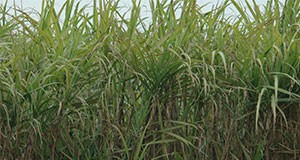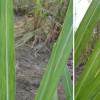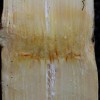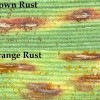
Ring spot, caused by the fungus Leptosphariea sacchari, is a disease of sugarcane that has been known to occur in Florida for over 80 years. Ring spot usually affects only the older leaves, and therefore is considered a minor disease. However, correctly identifying the disease in the field can help to reduce unnecessary chemical sprays. This two-page fact sheet outlines the symptoms and spread of the disease, as well as how to prevent and control Sugarcane Ring Spot. Written by P. Rott, J.C. Comstock, H.S. Sandhu, and R.N. Raid, and published by the Plant Pathology Department.
http://edis.ifas.ufl.edu/pp321
Tag: H.S. Sandhu
Effects of Harvest Method on Microclimate in Florida Sugarcane
 The production systems for sugarcane include either green cane or burnt cane harvesting operations. Sugarcane in Florida is typically harvested with burnt cane mechanical harvesting, but there is a growing interest to better understand the effects of green cane harvest residue “trash blankets” on microclimate conditions for sugarcane growing on both organic and mineral soils of Florida, so the authors conducted a three-year study to determine the effects of each harvest method on microclimate within the surface soil profile and at a 10 cm height from the soil surface. Results are presented in this 4-page fact sheet written by Hardev Sandhu, Maninder Singh, Robert Gilbert, Kelly Morgan, Ronald Rice, Leslie Baucum, James Shine Jr., and Mike Irey, and published by the UF Department of Agronomy, April 2015. (UF/IFAS Photo: Josh Wickham.)
The production systems for sugarcane include either green cane or burnt cane harvesting operations. Sugarcane in Florida is typically harvested with burnt cane mechanical harvesting, but there is a growing interest to better understand the effects of green cane harvest residue “trash blankets” on microclimate conditions for sugarcane growing on both organic and mineral soils of Florida, so the authors conducted a three-year study to determine the effects of each harvest method on microclimate within the surface soil profile and at a 10 cm height from the soil surface. Results are presented in this 4-page fact sheet written by Hardev Sandhu, Maninder Singh, Robert Gilbert, Kelly Morgan, Ronald Rice, Leslie Baucum, James Shine Jr., and Mike Irey, and published by the UF Department of Agronomy, April 2015. (UF/IFAS Photo: Josh Wickham.)
http://edis.ifas.ufl.edu/sc100
Sugarcane Mosaic
 Mosaic’s most distinctive symptom is a pattern of contrasting shades of green, often islands of normal green on a background of paler green or yellowish chlorotic areas on the leaf blade. It had not been a problem in Florida until 1996, when it was observed on CP72-2086, a major commercial cultivar, near the intersection of Hatton Highway and US 98. Presently, because of the limited acreage of CP72-2086, the disease is only a potential threat. This 3-page fact sheet was written by P. Rott, J. C. Comstock, R. A. Gilbert, and H. S. Sandhu, and published by the UF Department of Agronomy, February 2015. (Photo: Philippe Rott, UF/IFAS)
Mosaic’s most distinctive symptom is a pattern of contrasting shades of green, often islands of normal green on a background of paler green or yellowish chlorotic areas on the leaf blade. It had not been a problem in Florida until 1996, when it was observed on CP72-2086, a major commercial cultivar, near the intersection of Hatton Highway and US 98. Presently, because of the limited acreage of CP72-2086, the disease is only a potential threat. This 3-page fact sheet was written by P. Rott, J. C. Comstock, R. A. Gilbert, and H. S. Sandhu, and published by the UF Department of Agronomy, February 2015. (Photo: Philippe Rott, UF/IFAS)
http://edis.ifas.ufl.edu/sc009
Sugarcane Ratoon Stunting
 Ratoon stunting, also known as ratoon stunting disease (RSD), is considered by many sugarcane pathologists to be the most important disease affecting sugarcane production worldwide, because it can cause 5% to 15% crop yield losses without growers even realizing their fields are infected. This 3-page fact sheet describes the symptoms, causal agent, and prevention and control. Written by P. Rott, S. Sood, J. C. Comstock, R. A. Gilbert, and H. S. Sandhu, and published by the UF Department of Agronomy, August 2014. (Photo credit: Sushma Sood, USDA)
Ratoon stunting, also known as ratoon stunting disease (RSD), is considered by many sugarcane pathologists to be the most important disease affecting sugarcane production worldwide, because it can cause 5% to 15% crop yield losses without growers even realizing their fields are infected. This 3-page fact sheet describes the symptoms, causal agent, and prevention and control. Written by P. Rott, S. Sood, J. C. Comstock, R. A. Gilbert, and H. S. Sandhu, and published by the UF Department of Agronomy, August 2014. (Photo credit: Sushma Sood, USDA)
http://edis.ifas.ufl.edu/sc002
Sugarcane Orange Rust
 In June 2007, rust symptoms were observed on sugarcane cultivar CP80-1743 about six miles east of Belle Glade, Florida. The disease was confirmed as orange rust of sugarcane. It is hypothesized that rust spores were blown into the region as a disperse spore cloud from an unknown source rather than spread from a single or several small focal points. This 7-page fact sheet was written by P. Rott, S. Sood, J. C. Comstock, R. N. Raid, N. C. Glynn, R. A. Gilbert, and H. S. Sandhu, and published by the UF Department of Agronomy, May 2014.
In June 2007, rust symptoms were observed on sugarcane cultivar CP80-1743 about six miles east of Belle Glade, Florida. The disease was confirmed as orange rust of sugarcane. It is hypothesized that rust spores were blown into the region as a disperse spore cloud from an unknown source rather than spread from a single or several small focal points. This 7-page fact sheet was written by P. Rott, S. Sood, J. C. Comstock, R. N. Raid, N. C. Glynn, R. A. Gilbert, and H. S. Sandhu, and published by the UF Department of Agronomy, May 2014.
http://edis.ifas.ufl.edu/sc099
Lesser Cornstalk Borer Damage to Sugarcane and the Effects of Tillage and Harvest Residue Management (ENY454/SC094)
 This 6-page fact sheet provides an overview of this pest, its damage to sugarcane, and the plant’s response, and describes the results of a study of harvest residue and controlled tillage experiments. Written by Hardev S. Sandhu, Leslie E. Baucum, and Gregg S. Nuessly, and published by the UF Department of Entomology and Nematology, May 2012.
This 6-page fact sheet provides an overview of this pest, its damage to sugarcane, and the plant’s response, and describes the results of a study of harvest residue and controlled tillage experiments. Written by Hardev S. Sandhu, Leslie E. Baucum, and Gregg S. Nuessly, and published by the UF Department of Entomology and Nematology, May 2012.
http://edis.ifas.ufl.edu/sc094
Life Cycle of the Lesser Cornstalk Borer in Sugarcane (ENY913/SC093)
 The lesser cornstalk borer attacks a large number of crops, but is a potentially serious pest of sugarcane. But since the populations of this pest vary greatly depending on temperature, UF/IFAS scientists are developing predictive models to predict lesser cornstalk borer population in field. This 4-page fact sheet was written by H.S. Sandhu, L.E. Baucum, and G.S. Nuessly and published by the UF Department of Entomology and Nematology, September 2011.
The lesser cornstalk borer attacks a large number of crops, but is a potentially serious pest of sugarcane. But since the populations of this pest vary greatly depending on temperature, UF/IFAS scientists are developing predictive models to predict lesser cornstalk borer population in field. This 4-page fact sheet was written by H.S. Sandhu, L.E. Baucum, and G.S. Nuessly and published by the UF Department of Entomology and Nematology, September 2011.
http://edis.ifas.ufl.edu/sc093